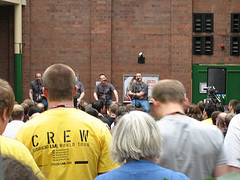Robert Collins: 16 Aug 2009
Hudson seemed quite nice when I was looking at how drizzle use it. I proposed it to the squid project to replace a collection of cron scripts and we re now in the final stages of deployment: Hudson is running, doing test builds. We are now polishing the deployment, tweaking where and how often reports are made, and adding more coverage to the build farm. I thought I d post a few observations about the friction involved in getting it up and running. Understand that I think its a lovely product these blemishes are really quite minor. Installation of the master machine on Ubuntu add an apt repository, apt-get update, apt-get install. Installation of the master machine on CentOS 5.2 (Now 5.3): make a user by hand, download a .war file, create an init.d script by copy-and-adjusting an example off the web. Plenty of room to improve here. Installing slave machines: make a user by hand, add an rc.local entry to run java on slave.jar as that new user. This could be more polished Installing a FreeBSD 6.4 slave: manually download various java sources to my laptop, scp them up to the FreeBSD machine, build *java* overnight, then make a user, add an rc.local entry etc. _Painful_. The next thing we noticed was that the model in Hudson doesn t really expose platforms but we want to test on a broad array of architectures, vendors and releases. i386-Ubuntu-intrepid building doesn t imply that i386-Debian-lenny will build. We started putting in tags on the slaves that will let us say this build is for amd64-CentOS-5.2 , so that if we have multiple machines for a platform, we ll have some redundancy, and so that its easy to get a sense of whats failing. This had some trouble its very manual, and as its manually entered data it can get out of date quite easily. So in the weekend I set out make a plugin, and ran into some yak shaving. Hudson plugins use maven2 to build and deploy. So I added the maven2 plugin to my eclipse (after updating eclipse to get the shiniest bzr-eclipse), and found the first bug issue 1580 maven2 and teamplugins in eclipse 3.5 don t play all that nice. Push. Removing bzr-eclipse temporarily allowed eclipse s maven plugin to work, but for some reason many dependencies were not found, and various discussions found on the net suggest manually adding them to the CLASSPATH for the project but not how to identify which ones they were. Pop. So, I switched to netbeans a 200MB download, as Ubuntu only has 6.5 in the archive. netbeans has the ability to treat a maven2 project as a directly editable project. I have to say that it works beautifully. Push. I made a new plugin, looked around for an appropriate interface, (DynamicLabellers, designed for exactly our intended use). Sadly, in my test environment, it didn t work the master didn t call into the plugin at all, and no node labels were attached. Push. Grab the source for hudson itself, find the trick-for-newcomers here do a full build outside netbeans, in netbeans open main/war as a project, and main/core as well, not just the top level pom.xml. To run, with main/war selected in the project list hit the debug button. However changes made to the main/core sources are not deployed until you build them (F11) the debug environment looks nearly identical to a real environment. Pop. There is a buglet in DynamicLabeller support in Hudson, where inconsistent code between general slave support and the master node Hudson.java causes different behaviour with dynamic labels. Specifically the master node will never get dynamic labels. So I fixed this, cleaned up the code to remove the duplication as much as possible (there are comments in the code base that different synchronisation styles are needed for some reason) and submitted upstream. Pop. I ll make the plugin for squid pretty some evening this week, and we should be able to start asking for volunteers for the squid build farm. Yay!





 Tired and under the influence of beer, I tried to remove the
Tired and under the influence of beer, I tried to remove the

